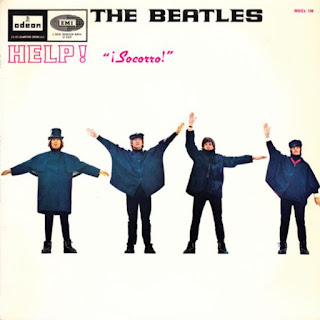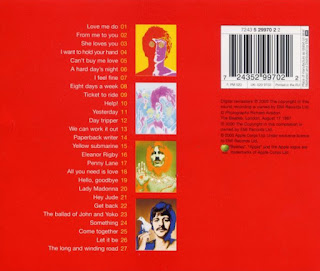THE BEATLES - TICKET TO RIDE
Publicació: 9 d'abril de 1965
Llistes: Regne Unit: #1 (3 setmanes) EUA: #1 (1 setmana)
"Ticket to Ride" és una cançó dels Beatles, escrita principalment per John Lennon i acreditada a Lennon–McCartney. Llançada com a senzill l’abril de 1965, es va convertir en el seu setè èxit consecutiu al número 1 al Regne Unit i el seu tercer èxit consecutiu al número 1 (i vuitè en total) als Estats Units. Enregistrada al febrer de 1965 als estudis EMI de Londres, la pista va mostrar una evolució en el so dels Beatles amb la incorporació d’una instrumentació més intensa en comparació amb les seves publicacions anteriors. La cançó també apareix al seu àlbum Help! del 1965.
Segons "A Hard Day's Write" de Steve Turner, molts americans creien que el títol "Ticket to Ride" es referia als ferrocarrils britànics i que "ride" indicava la ciutat de Ryde a l'illa de Wight. Paul McCartney va admetre més tard al biògraf Barry Miles que hi havia certa veritat en aquesta interpretació. Tot i que la cançó principalment descrivia una noia que marxava de la vida del narrador, McCartney va reconèixer que eren conscients del potencial d'un doble sentit, donat el seu viatge a Ryde on Paul tenia un cosí que portava un bar. Don Short, que va viatjar amb els Beatles als anys 60, recorda que John Lennon va inventar la frase "Ticket to Ride" amb una altra significació en ment. Segons Short, John va explicar que a Hamburg les noies que treballaven al carrer necessitaven un certificat de salut, i les autoritats els donaven una targeta que indicava que no tenien malalties. No obstant això, Short va reconèixer que John podria haver estat de broma, subratllant la necessitat de ser prudent amb les seves afirmacions.
"Ticket to Ride" va marcar un canvi notable pels Beatles com la seva primera cançó que superava els 3 minuts, influenciant una tendència cap a cançons més llargues. Cançons posteriors com "You Won't See Me" de "Rubber Soul" van seguir la mateixa línia. La tendència es va estendre amb cançons més llargues als àlbums com "Revolver" i, notablement, "Sgt. Pepper's Lonely Hearts Club Band", que presentava quatre pistes que superaven els 3 minuts, incloent-hi dues que superaven els 5. Això va marcar un canvi respecte a les seves composicions més curtes inicials i va preparar el terreny per a exploracions musicals més extenses en les seves obres posteriors, amb cançons com "I Want You (She's So Heavy)" i "Hey Jude" entre les més llargues.
El breu però reconeixible solo de guitarra va ser interpretat per Paul McCartney. Carl Palmer, conegut per ser membre d'Emerson, Lake & Palmer, va elogiar la feina de bateria de Ringo Starr a "Ticket to Ride", descrivint-la com excepcional i destacant-ne les qualitats emocionals i rítmiques.
Els Beatles van ser pioners en la creació de videoclips per promocionar les seves cançons sense haver de presentar-se als estudis de televisió. El vídeo de "Ticket To Ride" va ser part d'una gravació on van enregistrar quatre cançons més. Les imatges es van rodar a l'estudi, mostrant la banda actuant davant de bitllets de tren i autobusos gegants.
THE BEATLES - TICKET TO RIDE
Released : April 9, 1965
Charted: UK: #1 (3 weeks) US: #1 (1 week)
"Ticket to Ride" is a song by the Beatles, primarily written by John Lennon and credited to Lennon–McCartney. Released as a single in April 1965, it became their seventh consecutive number 1 hit in the UK and their third consecutive number 1 hit (and eighth in total) in the US. Recorded in February 1965 at EMI Studios in London, the track showcased a progression in the Beatles' sound with the incorporation of drone and a harder instrumentation compared to their previous releases. The song is also featured on their 1965 album Help!
According to Steve Turner's "A Hard Day's Write" many Americans believed the ticket in "Ticket to Ride" referred to British Railways, and ride indicated the town of Ryde on the Isle of Wight. Paul McCartney later admitted to biographer Barry Miles that there was some truth to this interpretation. While the song primarily depicted a girl leaving the narrator's life, McCartney acknowledged they were aware of the potential for a double meaning, given their visit to Ryde where Paul had a cousin with a bar. Don Short, who traveled with the Beatles in the '60s, recalled that John Lennon coined the phrase "Ticket to Ride" with another meaning in mind. According to Short, John explained that in Hamburg, the girls working the streets needed a clean bill of health, and authorities would give them a card indicating they were disease-free. However, Short acknowledged that John could have been joking, emphasizing the need to be cautious with his statements.
"Ticket to Ride" marked a notable shift for the Beatles as their first song over 3 minutes, influencing a trend towards longer songs. Subsequent tracks like "You Won't See Me" from “Rubber Soul” followed suit. The trend extended with longer songs on albums like “Revolver”, and notably, “Sgt. Pepper's Lonely Hearts Club Band”, which featured four tracks over 3 minutes, including two exceeding 5 minutes. This marked a departure from their earlier, shorter compositions and set the stage for more extended musical explorations in their later works, with tracks like "I Want You (She's So Heavy)" and "Hey Jude" among their longest.
The brief but recognizable guitar solo in the song was played by Paul McCartney. Carl Palmer of Emerson, Lake & Palmer fame praised Ringo Starr's drum work on "Ticket to Ride", describing it as exceptional and highlighting its exciting and rhythmical qualities.
The Beatles were pioneers in making music videos, creating them to promote their songs without needing to appear at TV stations. The video for "Ticket To Ride" was part of a shoot where they recorded four other songs. The footage was shot in the studio, featuring the band performing in front of oversized tickets for trains and buses.

































Cap comentari:
Publica un comentari a l'entrada